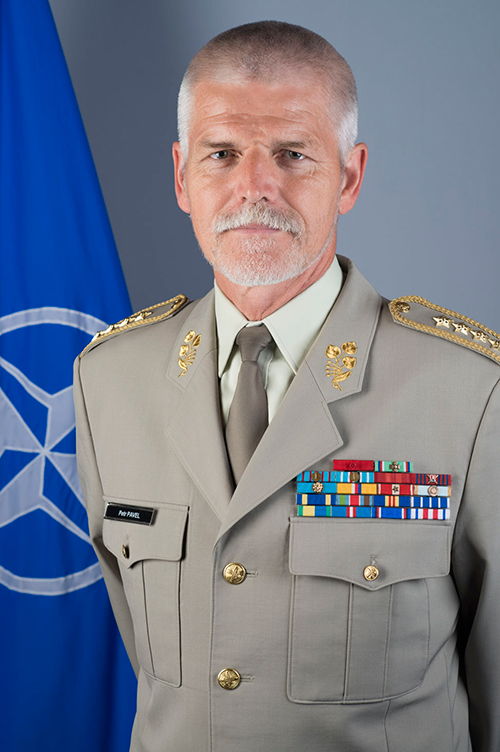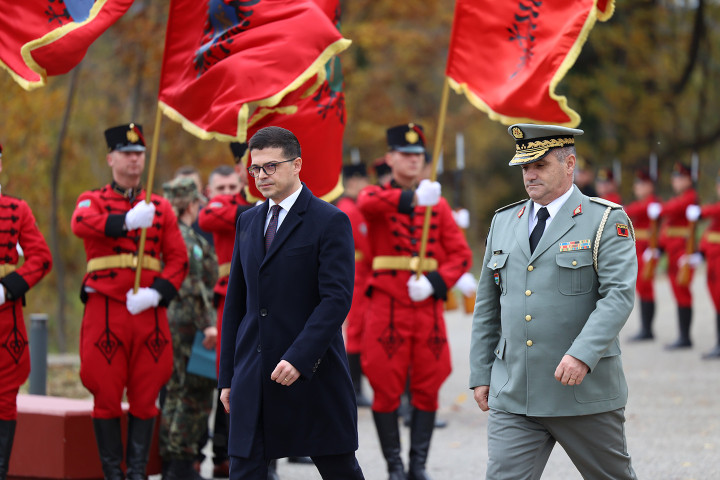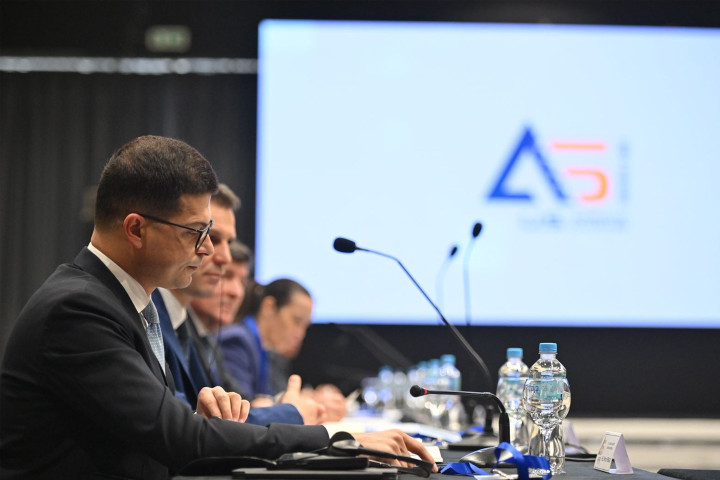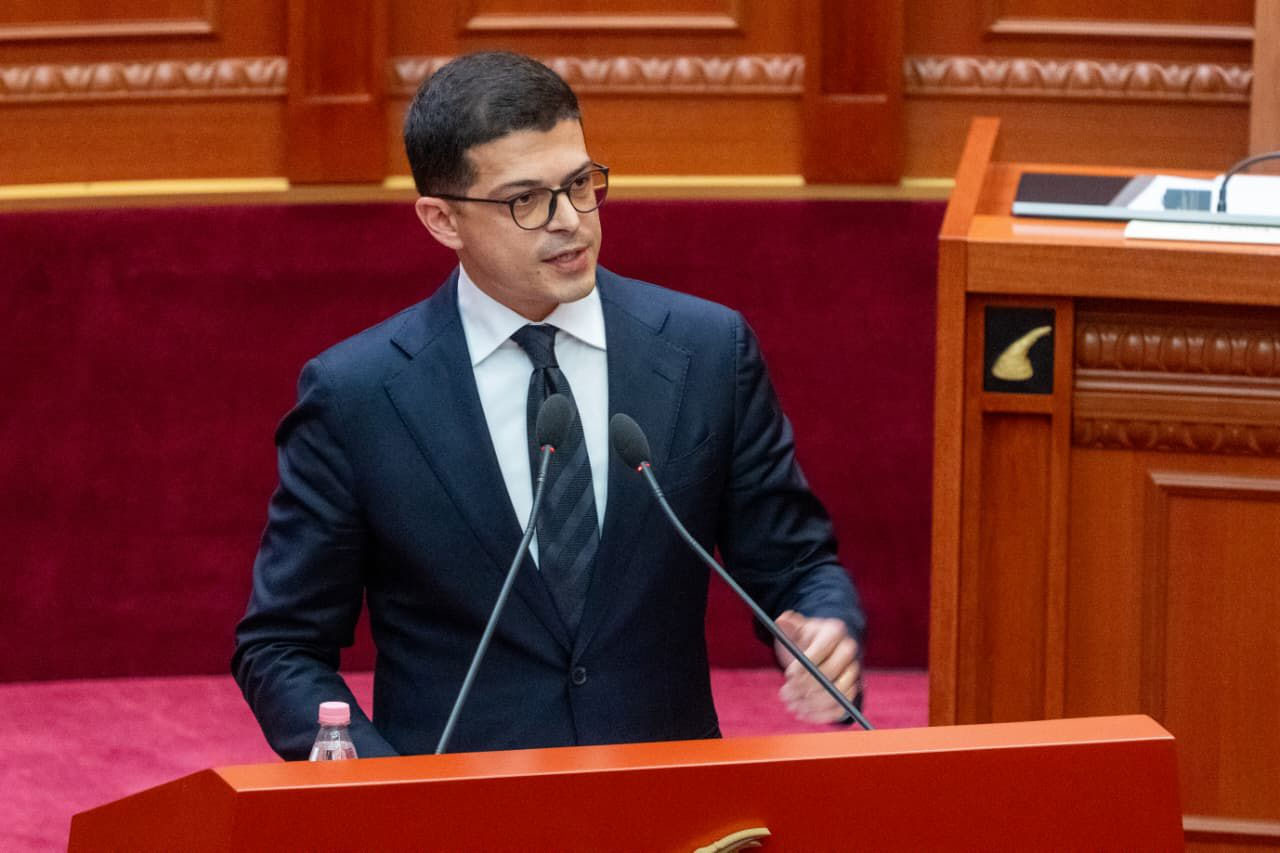Interview with General Petr Pavel, Chairman of the NATO Military Committee
 NATO in front of the new security challenges
NATO in front of the new security challenges
1. Tell us more about your role as Chairman of the NATO Military Committee and the Military Committee?
The Chairman of the Military Committee is elected by the NATO Chiefs of Defence, normally for a three-year term. As Chairman, I represent their consensus-based views and serve as the senior military adviser to the Secretary General, the North Atlantic Council and other NATO organizations. I guide the agenda and deliberations of the Military Committee, NATO’s highest military authority, listening to views and working to reconcile divergent national positions or policy differences to fashion advice that all can agree to. Each Nation has an equal voice in the discussions and decisions.
In addition, as the Alliance’s senior military adviser and spokesperson for the Military Committee, I regularly visit operations, missions, Allied and Partner countries to discuss NATO’s role and military work, as well as to maximize NATO military capabilities and efficiencies. I am assisted in my duties by the Deputy Chairman, Lt. Gen. Steven M. Shepro (US Air Force).
Lt. Gen. Shepro assists my role as principal adviser to the NATO Secretary General and senior military spokesperson of the Alliance. He also advises the Deputy Secretary General, leads coordination of nuclear, biological and chemical matters and, in my absence, directs daily operations and the business of the Military Committee.
As for the Military Committee, it was created in 1949 and is, after the North Atlantic Council, the second oldest permanent NATO body established in accordance with Article 9 of the Washington Treaty.
The Military Committee meets twice a year at NATO Headquarters in Brussels, at the level of Chiefs of Defence to discuss NATO operations and missions and provide the North Atlantic Council with consensus-based military advice on how the Alliance can best meet global security challenges. It also meets once a year in an Allied member country. On a day-to-day basis, their work is carried out by permanent Military Representatives at NATO Headquarters in Brussels.
2. As a new Chairman will be elected at the Conference in Tirana, can you reflect a little on your two years as Chairman and what are your goals for your last year in office?
My first two years in office have been characterised by the changes in the security environment and NATO’s adaptation. This is to ensure that the Alliance remains ready and able to meet any challenge or threat from any potential state or non-state actor from any direction. Through my Chairmanship of the Military Committee, I have been privileged to see how the Military Committee and my work has contributed to the implementation of the Readiness Action Plan, the Assurance and Adaptation measures, NATO’s reinvigorated deterrence and defence posture, our Projecting Stability concept, our enhanced Forward Presence in the Baltic States and Poland, tailored Forward Presence in Bulgaria and Romania, the smooth transition from our International Security Assistance Force in Afghanistan to our Resolute Support Mission to name but a few key areas.
My goals for my last year in office are, as you can imagine, very much in line with the subject areas to be discussed at the Military Committee Conference meeting in Tirana, together with the forthcoming tasks from the Foreign and Defence Minister’s meetings coming up in November and December, respectively. As Chairman of the Military Committee, I want to ensure that when I hand over my duties as much progress as possible has been made, that issues that have needed additional attention have been resolved, and that the Military Committee retains its record of producing sound military advice to inform the North Atlantic Council.
By the time I leave office, the NATO Command Structure Review will have been reviewed by the Defence Ministers and we should be working towards an approval of its recommendations and implementation. This will enable the Alliance to have the flexible, a “fit-for-purpose” Command Structure it requires.
Projecting Stability concept encompasses many work strands but at its core, is the work we do with our forty-one Partners and the cooperation we have in place with multinational organisations such as the European Union, United Nations, African Union and Organisation for Security and Co-operation in Europe. Moving forward, I expect that we will not only further tailor our support to Partners but increase our understanding of their needs, and where the Alliance can add value.
Terrorism, and the indiscriminate violence that is associated with it, concerns the Alliance. We have been increasing our efforts to assist in the fight against terrorism. Our work involves many different lines of effort and types of activity, ranging from our Resolute Support Mission in Afghanistan, to our training for Iraqi forces, to developing new technologies for de-mining or bomb detection. We have also increased the flight time of our AWACS surveillance aircraft supporting the Coalition, and we are increasing its support for Iraq and its security forces. In addition, we have set up a new Terrorism Intelligence Cell at NATO Headquarters, and have reached initial operation capability for the Hub for the South which is based at our Joint Force Command in Naples. The hub is designed to focus on concerns such as destabilization, potential terrorism, radicalization, migrations, environmental pollution and natural disasters. It will also serve as a point of focus for enhanced deconfliction and coordination between Allies and Partners to enhance comprehensive understanding, situational awareness, decision making and information sharing for the South. The hub will help us take stock of the current and potential threats, and with the Alliance’s experience and expertise, see how we can work with our Partners to provide a holistic solution, in concert with other relevant actors.
In addition, I will of course continue to focus on NATO’s operations, missions and activities. The Alliance and its Resolute Support operational partners have committed themselves to Afghanistan, and working with it as it puts in place its four year roadmap to further develop the Afghan security forces and institutions. This plan aims at turning the Afghan security forces and institutions into efficient and effective defenders of the Afghan Nation. It will cover several domains, such as combat capabilities, special operations forces, air force, command and control arrangements. NATO’s long term commitment to Afghanistan is key to Afghanistan’s security and to our own security.
Aside from our presence in Afghanistan, we are present in Kosovo through KFOR, in the Aegean Sea Region helping respond to the refugee and migrant crisis, in the Mediterranean with Operation Sea Guardian, our Air Policing missions during peacetime and our enhanced Air Policing in the Baltics and Romania and Bulgaria. At sea, we have our Standing Naval Maritime Groups and Standing Naval Mine Countermeasures Groups patrolling the waters and exercising as our Maritime Security is as important as our land or air security.
A subject that is often currently discussed is that of NATO’s relationship with Russia. When I took up my position as Chairman of the NATO Military Committee, we had suspended practical cooperation with Russia after her illegal annexation of Crimea and involvement in Eastern Ukraine. NATO has a united two-track approach to Russia: meaningful dialogue combined with strong defence and deterrence. We are delivering on both tracks. I recently met with General Gerasimov to discuss ways to enhance military-to-military communications and to contribute to risk reduction and transparency. We agreed to continue using the military lines of communication in the future, which I see as a very positive step.
3. NATO missions and Albania, what is your opinion on AAF's contribution to missions undertaken by NATO?
I am very grateful for Albania’s strong commitment to our Alliance and your contributions to NATO missions, operations and activities, namely our missions in Afghanistan and Kosovo. You do not have a very large Armed Forces, but you contribute as much as possible.
You also provide strong support to our partners, including contributions to our Trust Funds for Ukraine, helping with cyber defence and military career transition. In addition, Albania plays an important role in the fight again ISIL, providing equipment and Special Forces trainers to Iraq.
Albania also helps build stability closer to home, by promoting cooperation throughout the Western Balkans. You are a strong advocate for NATO’s Open Door policy, and for integrating your neighbours into the Euro-Atlantic family.
4. The Western Balkans region appears to have become a topic of high interest once more for the Alliance. Why the renewed focus?
The Western Balkans is a region of strategic importance for NATO and we have invested in the security and stability of the Western Balkans for more than two decades. With that assistance, the region has made significant progress since the 1990s. NATO has helped end two ethnic wars in the Western Balkans. Stability and security in this region benefits stability and security in Europe. We intend to maintain our presence, our focus and our engagement in the Western Balkans, and support the Euro-Atlantic aspirations of countries in the region.
Democratic values, rule of law, domestic reforms, and good neighbourly relations are vital for regional cooperation and stability. The Alliance sees the region’s future in Euro-Atlantic cooperation and integration for those who want it and we are determined to help the countries of the region to implement real reforms for the benefit of their citizens, regardless of whether they want to join NATO or not. We respect their choice, whatever it is.
In June this year, we welcomed Montenegro into the NATO family as our 29th Ally. This helps consolidate stability and security in the Balkans. The evidence is in front of us. Countries such as yours is a prime example as a Nation from the region who joined the Alliance and has become an exporter of stability to the Balkans and beyond. A stable Balkans is in all our interests.
5. KFOR is NATO’s longest running operation – how long KFOR continue to exist?
We have been present in Kosovo and leading a peace-support operation – the Kosovo Force (KFOR) – since June 1999. For the past eighteen years, KFOR has been helping to transform Kosovo into a safer place. We currently have around 4500 troops on the ground. However, NATO’s footprint in Kosovo goes beyond our military presence.
We are committed to capacity building. Our NATO Advisory and Liaison Team will play a key role in these efforts, including with support to the Kosovo Security Force. We have agreed to increase our cooperation in several areas, including cyber defence and fighting corruption.
In parallel, the normalisation process between Pristina and Belgrade is continuing. NATO fully supports the EU-facilitated dialogue, as this is critical for regional peace and security.
KFOR will continue its mission to preserve a safe environment and guarantee freedom of movement, for as long as necessary.
6. How does NATO perceive joint military exercises of Russia and Serbia in Croatian borders?
Every nation has the right to conduct exercises, as long as they do so within their international obligations, including notifying the actual numbers and providing observation opportunities when required. The Alliance routinely exercises with Allies and Partners from across the world.
In order to promote mutual trust and transparency, OSCE members are bound by the Vienna Document to inform one another in advance of exercises which include more than 9000 troops, unless the exercises are snap tests of readiness
What NATO does try to do is to strive for transparency and predictability regarding our military exercises. And in this spirit, you can easily find the schedule of our planned exercises on NATO’s website.
Training and exercises are an essential part of NATO’s adaptation. They help us to test procedures and tactics, identify best practice and areas for improvement.
With regard to Serbia, our ambitions are simple. Build a good and productive relationship with Serbia, so that we can work together in areas where both Serbia and NATO see value. We face the same security challenges in our shared Euro-Atlantic region, and dialogue and cooperation are important to address them.
7. What are the main challenges and threats currently facing the Alliance?
In today’s security environment, the threats and challenges at our periphery and beyond are as diverse as they are many. To be able to defend against any opponent or threat, NATO must have credible defence and deterrence, underpinned by the will to act. It is for this reason that NATO has undertaken the biggest reinforcement of its collective defence since the Cold War. NATO must ensure that it has a range of capabilities and options to respond appropriately when required.
One of the challenges at our borders is a more aggressive and assertive Russia – a Nation with whom the Alliance worked to build a partnership for more than two decades following the Cold War. The other is the fight against terrorism where we need to ensure we address not only the immediate problems but also the root causes.
The NATO-Russia partnership focused on a wide range of mutually beneficial areas from counter terrorism to crisis management for many years. However in 2014, Russia violated international law and undermined the European security order by illegally annexing Crimea. In addition, Russia heralds the presence of a formidable military posture which includes large scale and no-notice exercises, air space violations, the use of disinformation and more. As I stated earlier, we have a dual track approach to Russia, meaningful dialogue combined with strong defence and deterrence.
NATO has responded proportionately, defensively, and fully in concert with international law. Over the previous three years, our Alliance has tripled the size of NATO’s Response Force, created a strong spearhead or Very High Readiness Joint Task Force, established eight new small headquarters to facilitate reinforcements and training, and prepositioned equipment and supplies. These measures are being put in place to ensure our follow-on forces are trained, interoperable and capable to rapidly deploy in the face of any aggression. More recently at our NATO Summit in Warsaw, Heads of State and Government decided that four robust rotational multinational battalions will also be deployed in the eastern geographical region of the Alliance. These measures are neither an attempt to escalate the situation nor to provoke conflict. On the contrary, they are to prevent conflict.
Turning back to fight against terrorism, we need to bear in mind that terrorism has no religion or boundaries. It cannot simply be defeated militarily, but it had to be dealt with on several layers – socially, economically, politically as well as, when needed, militarily. There is no simple solution. Terrorism is not in itself new but has remerged in recent years, most significantly in the form of the Islamic State of Iraq the Levant or as it is also known Daesh. To be able to deal efficiently with a problem, we need to understand it and we need to use all the tools available. I believe that the Alliance’s efforts coupled with those of our Partners and multinational organisations we can greatly contribute to the demise of terrorism, but it will take time. There is no quick fix solution.
8. NATO is now part of the Global Coalition against ISIL. What is NATO doing regarding the fight against terrorism and how can the Alliance assist in dealing with the return of foreign fighters?
NATO has played a key role in the fight against terrorism for many years. At our Heads of State and Government meeting in May this year, NATO leaders agreed an action plan to step up NATO’s efforts in the fight against terrorism. Our work involves many different lines of effort and types of activity, ranging from our Resolute Support Mission in Afghanistan, to our training of Iraqi forces, to developing new technologies for de-mining or bomb detection.
I have already mentioned membership of the Global Coalition to Defeat ISIS, contribution of our AWACS surveillance planes, and creation of the Hub for the South
On the return of foreign fighters, this is a matter of serious concern. No region, no country, no community is immune to this threat. National police and judicial authorities play an important role.
Albania has offered to host a NATO Centre of Excellence on Foreign Fighters. NATO and Albania are coordinating the way ahead.
The Alliance itself has increased our information sharing among Allies, carried out training and is working with other countries to build their capacity to face such threats. Many Allies are also working closely with countries in the Western Balkans to address this issue. NATO has a role to play in countering terrorism and helping to build stability in our neighbourhood. We do this through our missions in the Balkans and Afghanistan.
9. Montenegro is the newest member of the Alliance and also one of Albania’s neighbours. What are your thoughts on Montenegro’s accession to NATO? How does this strengthen regional security?
Montenegro’s membership in NATO is about more than adding a seat at the table. It is about enlarging the family of democratic countries that want to defend our shared security. Montenegro’s membership will help consolidate stability and security in the Balkans. The evidence is clear.
Although the Montenegrin Armed Forces are not very large, they contributed to our International Security Afghanistan Force in Afghanistan and continue to be involved in our Resolute Support Mission to train, advise and assist the Afghan Forces and Government by providing troops as well as funding.
Montenegro also plays a positive role in enhancing regional and global security: in the Western Balkans, in West Africa and by their participation in safeguarding free flow of world commerce on the high seas off the coast of Somalia. Aside from Missions, Montenegro has also participated in many exercises,
Countries in the region which have joined the Alliance have become promoters of stability in the Balkans and beyond.
Montenegro already makes valuable contributions to international security.
10. Soon, in September, MCC will be organized in Tirana, what will be the object of this conference?
The Chiefs of Defence will discuss further implementation of the Projecting Stability concept, the security situation in the Western Balkans region and provide recommendations for the way ahead for the Resolute Support Mission in Afghanistan and Kosovo Force (KFOR). The CHoDs will exchange views on NATO’s Adaptation and receive briefings on the current status of the NATO Command Structure review. Finally, they will elect the next Chairman of the NATO Military Committee who will take office in summer 2018.
During their first session of the day, the Chiefs of Defence will discuss the Projecting Stability concept focusing on near and long term delivery of strategic objectives. They will review the progress of the NATO’s engagement in the fight against terrorism, the Defence Capacity Building Initiative, the NATO Training and Capacity Building in Iraq and the implementation of the Hub for the South.
NATO’s Adaptation will be the focus of the second session. The CHoDs will receive briefings from both Strategic Commanders, General Scaparrotti, Supreme Allied Commander - Europe and General Mercier, Supreme Allied Commander –Transformation. The Strategic Commanders will provide further detail on the progress made by both Commands. Ahead of the November Defence Ministerial, Chiefs of Defence will provide additional guidance on the NATO Command Structure Review as well as how best to bring greater coherence to ongoing and divergent work strands.
The third session will focus on our Resolute Support Mission and KFOR. The Chiefs of Defence will receive briefings from Commander Resolute Support, General Nicholson, and the Senior Civilian Representative, Ambassador Cornelius Zimmermann on Afghanistan while Commander KFOR, Major General Fungo will provide a briefing on Kosovo. The CHoDs will provide recommendations for both missions taking into account the security situations on the ground.
In their final session, the Chiefs of Defence will elect the next Chairman of the Military Committee, who will take office in 2018.
Articles from Newsroom
Thursday, 04 December 2025


Thursday, 20 November 2025

Albania and Italy expand the framework of Strategic Cooperation in the field of Defence
Friday, 14 November 2025
Rome joint government summit: Ministers Vengu and Crosetto sign Albania–Italy Defence Cooperation Agreement
Thursday, 13 November 2025
Minister Vengu: The 2026 Defence Budget, the most ambitious since NATO membership
Wednesday, 12 November 2025